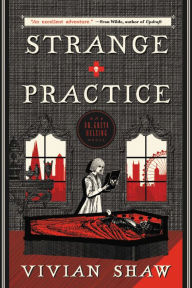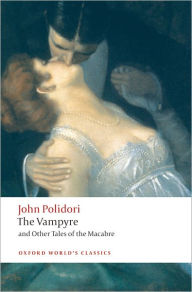Dr. Greta Van Helsing Heals the Sick Undead in Strange Practice
 For nigh on half a century, my grandfather was a what we would call a family practice doctor in a small town in the Midwest. He had a million stories of his long practice, everything from the reclusive survivor of the Titanic disaster who came in once a year from New England, to the time he diagnosed malaria at 10 paces in Duluth because he’d seen so much of it in the War. (“I feel terrible, Doc,” the man said. “You have malaria,” said my grandfather. The patient told that story forever: How did a doctor thousands of miles from endemic malaria do that?) My grandfather’s medical practice was bound indelibly with the community he served; sick and well, his trade was helping people. The main character of Strange Practice, the debut novel by Vivian Shaw, reminds me of my grandfather in the very best way.
For nigh on half a century, my grandfather was a what we would call a family practice doctor in a small town in the Midwest. He had a million stories of his long practice, everything from the reclusive survivor of the Titanic disaster who came in once a year from New England, to the time he diagnosed malaria at 10 paces in Duluth because he’d seen so much of it in the War. (“I feel terrible, Doc,” the man said. “You have malaria,” said my grandfather. The patient told that story forever: How did a doctor thousands of miles from endemic malaria do that?) My grandfather’s medical practice was bound indelibly with the community he served; sick and well, his trade was helping people. The main character of Strange Practice, the debut novel by Vivian Shaw, reminds me of my grandfather in the very best way.
Strange Practice (Dr. Greta Helsing Series #1)
Strange Practice (Dr. Greta Helsing Series #1)
By Vivian Shaw
In Stock Online
Paperback $19.99
Admittedly, there are a lot of differences, so let’s get those out of the way first: Dr Greta Helsing is in her mid-30s and lives in London, where she has recently inherited her father’s medical practice. Dr. Helsing, like her father before her, ministers to the ghouls and vampires and mummies of the capital city and beyond. (As far as I’m aware, Grandpa only ministered to humans.) Secrecy is maybe just as important as medicine for many of her patients, and Greta goes well out of her way to make sure the supernatural denizens of her practice are given the best care she can manage. There’s never enough money, and sometimes her patients are more obstreperous than she’d prefer, but she genuinely loves her work.
The action starts with a house call. She visits Edmund Ruthven, one of London’s oldest vampires, because Sir Francis Varney, another aged vampyre (the y denotes certain morphological differences), arrived on Ruthven’s doorstep after being viciously attacked by men dressed as monks. Though most vampires (and vampyres) tend to heal quickly, Varney’s cross-shaped puncture wound is festering, and he’s running the vampire equivalent of a fever. Helsing works through the night, plied with expertly made coffee and strangely perfect surgical expertise by Ruthven, and manages to stabilize the vampyre.
Admittedly, there are a lot of differences, so let’s get those out of the way first: Dr Greta Helsing is in her mid-30s and lives in London, where she has recently inherited her father’s medical practice. Dr. Helsing, like her father before her, ministers to the ghouls and vampires and mummies of the capital city and beyond. (As far as I’m aware, Grandpa only ministered to humans.) Secrecy is maybe just as important as medicine for many of her patients, and Greta goes well out of her way to make sure the supernatural denizens of her practice are given the best care she can manage. There’s never enough money, and sometimes her patients are more obstreperous than she’d prefer, but she genuinely loves her work.
The action starts with a house call. She visits Edmund Ruthven, one of London’s oldest vampires, because Sir Francis Varney, another aged vampyre (the y denotes certain morphological differences), arrived on Ruthven’s doorstep after being viciously attacked by men dressed as monks. Though most vampires (and vampyres) tend to heal quickly, Varney’s cross-shaped puncture wound is festering, and he’s running the vampire equivalent of a fever. Helsing works through the night, plied with expertly made coffee and strangely perfect surgical expertise by Ruthven, and manages to stabilize the vampyre.
Varney The Vampire; Or, The Feast Of Blood
Varney The Vampire; Or, The Feast Of Blood
By
James Malcolm Rymer
Editor
Curt Herr
In Stock Online
Paperback $34.99
If any of those names sound familiar, it’s because they should. One of the more charming aspects of Strange Practice is the way Shaw wends in characters from penny dreadfuls and Gothic novels, but updates them for the modern day. Sir Varney is the main character of a mid-19th C penny dreadful called Varney the Vampire; or, the Feast of Blood. (How I adore Victorian titling.) A somewhat soapy tale in the vein of Dark Shadows, Varney the Vampire influenced Bram Stoker’s Dracula. Speaking of Dracula, Greta Helsing’s family dropped the Van in Van Helsing, the surname of the vampire hunter in that work, after they traded from antagonism toward the supernatural for understanding. Edmund Ruthven is the vampire protagonist of The Vampyre, written by John Polidori, though often attributed to Lord Byron. Both The Vampyre and Mary Shelley’s seminal Gothic novel Frankenstein come out of the same fireplace literary dare, one attended by some of the foremost writers of the day. Sometimes this kind of allusiveness can be annoying, butShaw does a wonderful job tipping the hat to her literary forebears without sweating the details overmuch.
If any of those names sound familiar, it’s because they should. One of the more charming aspects of Strange Practice is the way Shaw wends in characters from penny dreadfuls and Gothic novels, but updates them for the modern day. Sir Varney is the main character of a mid-19th C penny dreadful called Varney the Vampire; or, the Feast of Blood. (How I adore Victorian titling.) A somewhat soapy tale in the vein of Dark Shadows, Varney the Vampire influenced Bram Stoker’s Dracula. Speaking of Dracula, Greta Helsing’s family dropped the Van in Van Helsing, the surname of the vampire hunter in that work, after they traded from antagonism toward the supernatural for understanding. Edmund Ruthven is the vampire protagonist of The Vampyre, written by John Polidori, though often attributed to Lord Byron. Both The Vampyre and Mary Shelley’s seminal Gothic novel Frankenstein come out of the same fireplace literary dare, one attended by some of the foremost writers of the day. Sometimes this kind of allusiveness can be annoying, butShaw does a wonderful job tipping the hat to her literary forebears without sweating the details overmuch.
The Vampyre and Other Tales of the Macabre
The Vampyre and Other Tales of the Macabre
By
John Polidori
Editor
Robert Morrison
,
Chris Baldick
In Stock Online
Paperback $9.95
In the morning, after Varney is stabilized, Greta heads back to her practice, and Ruthven works a source in the British museum. They’re all suspicious the attack on Varney is related to a series of killings attributed to “The Rosary Ripper,” a serial killer who has put London on edge, murdering women and stuffing cheap plastic rosaries into their mouths. Greta ministers to ghouls and mummies; Varney recuperates; Ruthven works his considerable contacts. Like any great detective yarn (much of medicine is detective work), Greta’s efforts to minister to her patients dovetails into larger, more dastardly plots, ranging both above and below the city and through a considerable amount of history.
This book is a joy to read, unlocking every bit of delicious promise in the premise. It’s peopled with fun and interesting characters. I certainly want to know much more about Fastitocalon, a good friend of Greta’s father who views her protection as a familial duty, and is also of unknown supernatural stock. The way the novel uses its London setting is a credit to that fine city. But the thing I find so compelling about Strange Practice is the fundamental decency of its main character: Dr. Greta Helsing practices a formidable sort of kindness, looking on her secret and sometimes monstrous community, and doing everything in her power to ease their ills. Medicine is a practice, and she’s working towards its performance of good every day.
Strange Practice is available July 25.
In the morning, after Varney is stabilized, Greta heads back to her practice, and Ruthven works a source in the British museum. They’re all suspicious the attack on Varney is related to a series of killings attributed to “The Rosary Ripper,” a serial killer who has put London on edge, murdering women and stuffing cheap plastic rosaries into their mouths. Greta ministers to ghouls and mummies; Varney recuperates; Ruthven works his considerable contacts. Like any great detective yarn (much of medicine is detective work), Greta’s efforts to minister to her patients dovetails into larger, more dastardly plots, ranging both above and below the city and through a considerable amount of history.
This book is a joy to read, unlocking every bit of delicious promise in the premise. It’s peopled with fun and interesting characters. I certainly want to know much more about Fastitocalon, a good friend of Greta’s father who views her protection as a familial duty, and is also of unknown supernatural stock. The way the novel uses its London setting is a credit to that fine city. But the thing I find so compelling about Strange Practice is the fundamental decency of its main character: Dr. Greta Helsing practices a formidable sort of kindness, looking on her secret and sometimes monstrous community, and doing everything in her power to ease their ills. Medicine is a practice, and she’s working towards its performance of good every day.
Strange Practice is available July 25.


